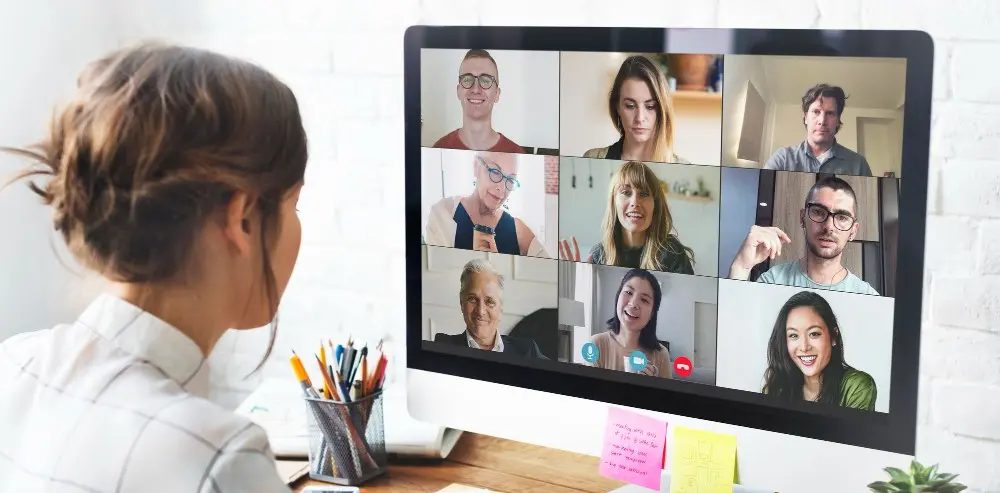Zippia reports that, as of 2023, a staggering 63% of high-growth companies have employed ‘productivity anywhere’ work models.
The constantly expanding market for a hybrid model of offices, as well as the remarkable surge in ‘open-plan’ offices’ has changed how offices look. One key change is that enterprises are looking to optimise their office space in such a manner that working online and conducting online meetings even while being in the office is not difficult. Given the sheer weight of employee and customer transactions being conducted over digital channels, it is incredibly important that real-time communications, especially video calls, do not get hampered.
It has become the remit of Customer Experience Officers (or what all CxOs could be called today!) must maintain the best video call standards to create a lasting impression and ensure smooth and seamless communication.
In an age when technical efficiency is the winning factor in making an excellent first impression, clear communication also plays a crucial role in instilling confidence among stakeholders.
Here are some of the best video-calling practices that CXOs should keep in mind to ensure enhanced productivity and efficiency.
Creating Mini Rooms
Mini Rooms are rapidly growing as enterprises are resorting to a seamless hybrid workplace experience. This involves customising the office space so that a separate space is left out just for video conferencing for just one or two people. While most office spaces have large or medium-sized conference rooms, a mini room is for when a single employee utilises extra space in the office as a quiet corner.
Moreover, this is a relatively cheaper and easily scalable practice that greatly impacts how people perceive communication within the enterprise. However, if mini-rooms don’t seem feasible for your company, then a mini-conference or a quiet room works as well. CXOs just need to make sure that the room is quiet, is equipped with robust AV solutions, and has suitable device and internet connectivity.
Appropriate Use of Headphones
Be it working from a corporate office space or from home, a noisy background can impede communication. Regardless of where you’re working from, lots of unnecessary background noise can transpire at times. Thus, CXOs must ensure that wearing headphones is a common practice. Avoiding this just leads to people focusing more on the distracting noise than on what you have to say, and vice versa. A good headset will make sure to virtually eliminate any and all distracting sounds and enable clear hearing on both ends.
A quiet area and required technical assistance like headphones ensure that employees can prioritise the meeting instead of other external factors and thus effectively communicate the requirements with the team or even with the client.
Choosing the Correct Backdrop
More often than not, meetings occur while both parties have their cameras on. Thus, businesses need to make sure that the backdrop they choose props up the way they are looking on camera — that is, looking presentable during the meeting. Make sure to avoid having a window as your backdrop during the meeting. While they are indeed a great source of natural lighting, having them at the back of your head does nothing but create a strong silhouette effect, thus shadowing the face and negatively impacting the quality of the meeting.
Make sure to have such light sources in front during a meeting so that the face gets properly illuminated. Learn more about the importance of proper lighting in the workplace here.
Preparations Before a Meeting
While conducting a video conference is relatively easy and involves just sending a meeting invite and joining the same, a little preparation never hurts. Make it a practice to join at least 5 minutes before the time of the meeting to make sure that the audio and video configurations are to the liking. Also, ensure to facilitate a stable internet connection and good lighting and camera quality.
If employees are presenting something to the clients, then it is advisable to have a run-through once to avoid any kind of logistical and technical hitches during the meeting. The idea is to keep it as smooth as possible, and prior preparation can help with just that.
Other than such technical preparations, there are also certain other preparations to consider. These include preparing a clear agenda for the meeting and making sure to adhere to that agenda throughout the meeting. Letting other members know about the agenda of the meeting in advance helps them to come prepared, too, with their own questions, doubts, opinions, and ideas. Taking such measures ensures that the meeting is highly interactive and productive instead of being one-sided.
Selecting the Best Video Conferencing Solutions
After evaluating the enterprise’s video conferencing and meeting requirements, it is important to find the perfect video conferencing solution that will best suit your business. The growing need to conduct meetings virtually calls for setting up an entire conference room or boardroom in such a way that it is fully equipped to hold virtual meetings, both internally and with customers.
Make sure to have provisions for most kinds of wired and wireless connectivity, as well as big screens and quality lighting that is bound to make a good first impression on the client. Also, ensure that the AV solution partner provides consistent support to ward off any technical problems that might transpire over time.
The Bottom Line
The best video calling practices can be realised only when you have the best AV solutions to help you out with the same. Along with such assistance, ensure you have a clear idea of the essential boardroom and other virtual meeting etiquette when holding a meeting.
Document your enterprise’s AV requirements and preferences for ensuring seamless video conferencing and enhanced communication.
Let Resurgent help you out with this. Book a free consultation with our experts today!



